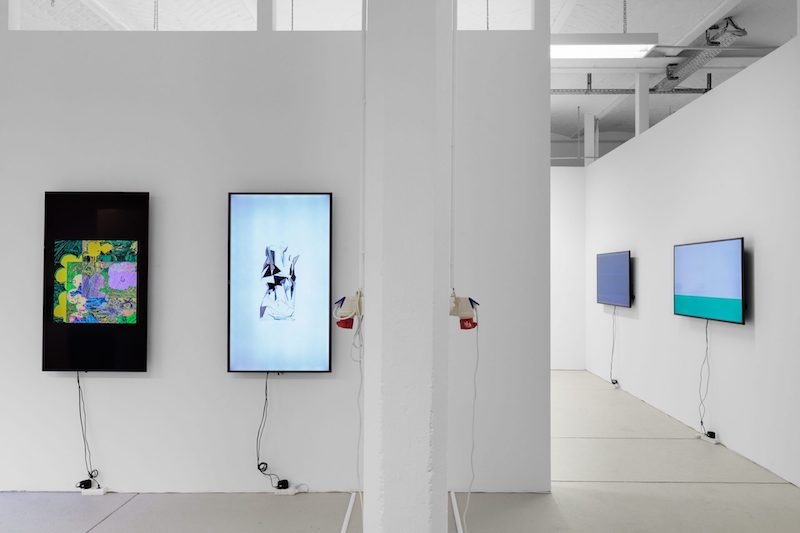As told to Samantha Ayson, 1735 words.
Tags: Technology, Art, Activism, Identity, Process, Inspiration, Money.
On art as a playground of ideas
Visual artist and hacker Rhea Myers discusses blockchain art pioneer on privacy, identity play, and crypto as the imaginary and the material.Your most recent work, Titled (Information as Property as Art) [Ethereum Null Address] is so clever. What’s your process like when you come up with a new artwork?
Artists never have a good answer to “where do your ideas come from.” In my case I usually cram my brain with research over the months until a project idea that won’t leave me alone starts to form. I then avoid questioning it until after the project is finished, at which point its relationship to what I had immersed myself in usually becomes obvious. So there’s a strong unconscious component to my workflow, which I think might surprise people. It’s one of the reasons art takes time for me to make.
Titled (Information as Property as Art), [Ethereum Null Address]
For this particular project the search space was constrained to the Albright-Knox Art Gallery’s collection, and there was a deadline. Which was nerve-wracking, as I get performance anxiety in that kind of situation. But curator Tina Rivers Ryan at AKG, who curated the work as part of the Peer to Peer exhibition, has been a fantastic collaborator within the institution.
We recognized Joseph Kosuth as someone in the AKG collection whose work obviously chimed with what I’ve been doing, and I pitched ideas based on a couple of different works by him. We then honed in on his “Titled” dictionary definition enlargements and I made six quite different presentations of the Ethereum null address inspired by this before we finalized the one you see above.
At first we were worried it might be too simple, but this was one of those irresistible ideas and of course over time it became obvious that it rewards contemplation in the way I always want my work to. Tina’s catalog essay is awesome for unpacking this and everyone should read it. I have a couple of git repos of preparatory work from the project but they’re not public. I think only Tina has seen everything that’s in them.
In the past you’ve said, “Everyone is terrified of owning a fake,” which is also a concept you play with in a lot of your works. Where do you think this fear comes from?
It’s the double-spending problem in art. With electronic currency, you need a way to know that any value you are sent hasn’t also been given to someone else, rendering it worthless to you. Bitcoin solves this in a decentralized way, and smart contract platforms like Ethereum inherit that solution. But visual art isn’t like protocol-level coins on a chain, so there’s various mismatches between the artworld problem of the fake (and it’s a big problem, up to half of the art in circulation may be fake) and the technological affordances of the blockchain as a solution to that.
If you’re an artist using those technological affordances as a medium, this is good because it gives you materials to use creatively to draw in and critique wider issues of authenticity, identity and ownership. If however you’re trying to use those affordances directly to establish authenticity, identity, and ownership you may end up in trouble. Nobody wants a cuckoo in the nest of their art collection.
For all the cynicism that it’s easy to feel about provenance trumping aesthetic content in establishing the price of artworks at auction, authenticity can be important for that very content. We can view this through Nelson Goodman’s argument in “Languages of Art”—even if we cannot distinguish a fake today, we cannot guarantee that it does not contain the information that we need to distinguish it from an authentic artwork in future. And that information may be part of the work’s content.
So the anxiety of authenticity is a matter both of not being sold the Brooklyn Bridge and of not admiring an air conditioning fixture as a sculpture by mistake. This affects the reputation of the collector, seller, critic, or art historian, but it is not reducible to a status game. It matters to people in private as well, whether dollars and cents, or meaning and sense.
Certificate of Inauthenticity, 2020, ERC-721 Tokens
Expanding on “anxiety of authenticity,” you’ve also previously said that’s what currently haunts the contemporary art world. Internet culture seems to be moving quickly past favoring “authenticity” and more towards “identity-play.” What effects do you think this will have over the next decade on art making?
The internet was a site for identity play in the 1990s. 2000s social media reduced that to singular authentic identities in order to sell to them, then maximized “engagement” between them. But none of us are reducible to a single role, and not all of us fit into the database columns that lurk behind like buttons. Danah Boyd’s research on this makes the problems very clear.
The cypherpunk ideal of privacy through secrecy comes from that same era and is encoded into crypto. That’s a good thing (on balance). Satoshi [Nakamoto] told people to never re-use Bitcoin receiving addresses, but “web3 identity” wants to tie us back to singular online identities again, just with an extra layer of cryptography. This is a long way from identity play.
But identity isn’t a late or disposable addition to crypto—a cryptographic key is an identity for a particular value of “identity.” And to borrow Isaiah Berlin’s concepts of liberty, crypto gives us both negative freedom (freedom from control through privacy and commitment) and positive freedom (freedom to experiment in a new space and to pay for those experiments). Those freedoms support self-realization which includes identity play, identity discovery, and identity exploration.
We’re seeing the effect of this already in the rapidly evolving microcultures of pfp projects. And with artists like Fewocious living their best lives via NFTs. I don’t think people have to always play with identity, if you find something that works then you can dig into that rather than needing to go further afield. Crypto as both an imaginary and a material resource can contribute to both.
Installation view, NfTNeTArT from Net Art to Art NFT, 2022; Photo: Marjorie Brunet Plaza
There’s been many conversations in the NFT space about auction houses and cultural institutions taking more of an interest in digital art. As someone who has been making blockchain art for many years, and has participated in exhibitions and auctions, what do you think about this?
Artists gotta eat. Crypto shows who is paying for your meal ticket more clearly than many people are used to. I think that’s a good thing for being able to critique the artworld, but if you come from academia or nonprofits it can be jarring.
General opinion pivoted from “computers can’t make art, digital art is boring” to “everybody uses computers to make art, digital art is boring” in the 2000s without pausing to recognize the historical value of digital art. That historical slight is being corrected now thanks to NFTs.
I’ll get into trouble if I say that you couldn’t buy digital art before—I know people who worked very hard to make that happen long before NFTs were a thing. But tying digital art to financial value in a transparent way using a digital medium seems to make that possibility click for a wider audience in a way it didn’t before. The knowledge that institutions can bring to that encounter with an audience can be so valuable. I love the ability of galleries and auction houses to provide historical context for and share understanding of my work.
None of this is to say that I’m not excited by new ways of organizing the commissioning, exhibition, sale, and critique of art that the blockchain enables. Recreating those institutions onchain, and creating new alternatives to them, in a transparent hackable medium that unifies communication, code, and value, is a historical opportunity for art.
I hope that each can learn from the other.
Simple Blockchain Art Diagram, 2016, digital media (After MTAA ca. 1997)
The gap between having any understanding of art history, and being part of the crypto scene, is wide. Does this gap need to be bridged?
That gap is where I started. I think that art and crypto can be put into a mutually productive relationship of critique. Art is a playground for new ideas, and the stakes are lower there than in, say, healthcare. And crypto is such an intense and accelerated reflection of post-financial-crash society. I wanted to get past their mutual distrust.
Crypto now has its own art history, and art has its own history of crypto use. But that has produced two additional gaps rather than closing the one that we started with. Which is frustrating because NFTs come from the art world originally to a large degree.
Maybe these gaps will disappear as the recuperation of crypto continues. Either because crypto fades into wider society and loses its alterity, or because the history of art becomes entangled enough with crypto that people have to learn about it to fully understand either.
 Tokens Equal Text, 2019, Ethereum ERC-998 and ERC-721 tokens
Tokens Equal Text, 2019, Ethereum ERC-998 and ERC-721 tokens
I ask because your work, specifically “Tokens equals Text,” rewards a knowledge and understanding of both worlds. You’re both playing with and critiquing the tension between aesthetic primitives and token standards—NFT art. What do people not yet fully understand about your work—and practice—that you wish they did?
I guess it’s that the work is all part of the same process of understanding. You’re following me as I work out what the questions are, or at least the territory. The writing doesn’t describe the images and the images certainly don’t illustrate the writing. They follow on from and call out to each other. And you can all follow that, too.
Rhea Myers Recommends:
Zeros and Ones - Sadie Plant.
Essays on Art & Language - Charles Harrison.
Crypto Anarchy, Cyberstates, and Pirate Utopias - ed. Peter Ludlow.
Digital Cash - Finn Brunton.
Art After Money, Money After Art - Max Haiven.
Radical Friends - eds. Ruth Catlow & Penny Rafferty.
Surfing With Satoshi - Domenico Quaranta.
Artists re:Thinking The Blockchain - eds. Ruth Catlow et al.








